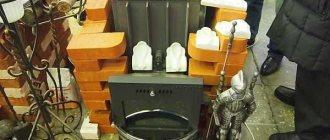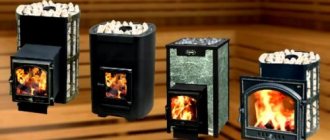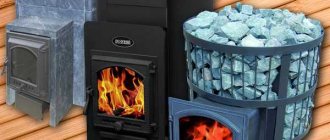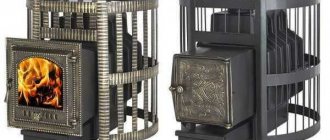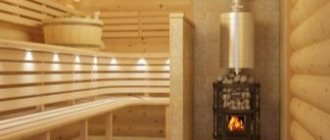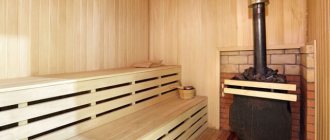Most of us think that lighting a stove is very simple. He threw in some wood, added some paper, set it on fire and that was it. Actually this is not true.
Preparing the oven
First you need to clean the firebox and chimneys from soot and seal all the cracks. Then check that you have a poker, a scoop for removing ash, and thick mittens to protect your hands from burns.
Pre-prepared fuel must be dry. Steam from wet fuel condenses on the walls of the furnace channels and cools them. Coal for the fire must be of high quality and free of dust.
Next, we check the draft in the oven. After opening the chimney damper, you can simply put your hand inside the firebox. If you feel a puff of air, then everything is fine. You can also check the draft with a burning match or paper.
After making sure there is traction, we clean the grate and ash pan.
Furnace firing stages
After preparation, we begin to fire the stove. Main stages of working with fuel:
- Kindling . Dry residues from cutting firewood and working with wood are suitable for kindling: wood chips, shavings, birch bark and small brushwood. Chips can be cut with a knife from small dry logs. The kindling is placed on crumpled newspaper, several large logs are added on top so that the firebox is filled to a third of its height, and it is set on fire.
- Main bookmark submission . The first portion of fuel is placed tightly, covering the entire area of the grate. Subsequent bookmarks should be placed on large coals from previous portions. There must be at least 100 mm from the surface of the fuel to the top of the firebox. The furnace door closes, and the ash door opens slightly. The air supply is regulated by furnace valves.
- Combustion process . With proper air supply, the flame is straw-colored and the burning wood crackles slightly. If the flame is white and the firebox is humming, you need to reduce the air supply. If the fire turns dark red and smoke appears, increase the air supply. Logs of the same size burn perfectly. To obtain heat, it is necessary to adjust the damper on the chimney, the damper and the ash door, trying to prevent carbon monoxide from entering the room, but also without releasing all the heat from the combustion.
- Completion . When the open flame disappears above the coals, you need to half-close the damper and use a poker to move the remaining coals to the center of the grate. After the flame completely disappears, close all the doors and the view damper completely. If you don’t have time to wait for the coals to burn, remove them from the firebox and close the dampers and valves.
Safety regulations
The main hazards when using furnaces are carbon monoxide and fire. For safety reasons, follow a few rules:
- inspect the stove before lighting for traces of soot;
- do not use flammable liquids for ignition;
- finish heating 2 hours before bedtime;
- Use fuel that is suitable for this type of stove.
In conclusion, we note that brick stoves are heated to the maximum, and metal stoves - in small portions to avoid warping of the body.
Many bathhouse lovers or those who have a wood-burning stove have repeatedly wondered how to properly heat the stove.
In fact, it is simple and there are no particular difficulties, but you need to know a few rules and follow them, and also know a little about the properties of firewood.
Different types of firewood are divided into 2 categories, high efficiency firewood and low efficiency firewood.
High efficiency firewood includes:
Advantages of the Vesuvius cast iron stove
The unit is installed so that fuel can be supplied from the bathhouse adjacent to the steam room. It’s not for nothing that the stove is popular among steam lovers, as it has a number of undeniable advantages:
- does not undergo deformation when working at high temperatures;
- the balance of the efficiency coefficient when heating air and stones for the bath is well selected;
- the stove is produced with sufficient capacity for storing fuel;
- the door in the oven cools itself; some models have self-cleaning glass;
- refers to environmentally friendly equipment, as it is made from safe materials;
- due to its successful design, it has high strength, which makes it possible to operate the unit for a long time without breakdowns;
- compared to traditional brick analogues, it is relatively light in weight and does not require a base or foundation during installation;
- the room heats up immediately, and the stove cools down gradually, the heat is retained after 10 hours;
- installation is carried out quickly, after which the stove is immediately ready for use, if necessary, it can be moved to another place after simple dismantling;
- If it is necessary to fit the equipment into the stylish interior of the bathhouse, decorating with figured bricks or ceramics can be easily done.
Consumers liked these ovens because they conveniently use control valves to control convection flows . The stove casing does not “foul”, according to reviews from bath attendants, and the heat in the steam room of the bath reaches a temperature of 80ºC. The negative aspect of operation is that if the heater is an open type, then despite the spectacular appearance, the stones cannot heat up to the required temperature and the steam coming from them is viscous and heavy.
It should be noted that even a successful design of the outer mesh with laid stones does not create the steam for which the Russian bathhouse is famous. Therefore, to create a Russian steam bath with its characteristic temperature and high humidity, you need to install a closed stove. If you want to install an open firebox, additional devices should be made to increase efficiency.
Results of operating the stove after the onset of cold weather
After the onset of cold weather, it became possible to evaluate the results of full operation of the device and slowly talk about the conclusions that emerged. At that time, the stove cost the author 15,300 rubles. The chimney is a little more expensive, more than 17,000 rubles. Now about the operation of the stove in severe frosts. She coped with the frost, but with great difficulty. The point here, apparently, was the volume of the firebox. But the frosts were severe, down to -30 degrees. When choosing a stove, the author was not guided by this temperature outside the window. There was a concept that a large firebox volume in relatively warm weather would cause excessive consumption of firewood - and this is true, but the heat did not increase. Another tile burst during use. The author tried to figure it out and it turned out that it was squeezed out by the fittings, which in turn should have strengthened the side wall of the furnace. Therefore, the sheet iron was deformed, square reinforcement was welded vertically to the entire height, but apparently the distance to the tile itself was violated. This conclusion was made because on the other side the distance was greater. Firewood was consumed very heavily during the cold winter period. And this despite the fact that ash wood was used.
Features of the Vesuvius sauna stove
The most successful feature is the round design of the case. It is this form that ensures uniform distribution of heat rays . A sauna stove with an outer casing made of high-strength steel plates looks unusual and is recognizable by its characteristic shape. The stones in the mesh are placed evenly, thanks to this, their heating is better and at the same time the hard infrared rays from the metal walls of the firebox are extinguished.
Laying stones in an open heater can help create the atmosphere of a dry Finnish sauna, but not a Russian bathhouse. When operating an open oven, water is poured onto the heated stones. To create an atmosphere of dry steam, tubes are inserted into the stones, through which moisture and herbal infusions are supplied. Steam, falling on the lower layers of hotter stones, becomes drier, and rising through the upper layer, it becomes finely dispersed and is further dried.
So they try to bring the conditions closer to the Russian steam room, but pouring water into the tubes while standing in front of the hot surface of the heater is inconvenient, and the escaping steam prevents this from being done. It's very easy to get burned doing this kind of work. You have to place the tubes in the stones at random; if effective steam cannot be achieved, then you have to rearrange the tubes and shift the already hot stones, which is completely inconvenient.
Oven operation
Models of units with a closed firebox are more suitable for a Russian bath, but only when it is possible to regulate the temperature of the stones and the heat output by opening and closing the upper part of the stove. Some models have cases covered with silicon-organic coating to protect the case from destruction by high temperature water. Such models look stylish, but if we are talking about the possibility of making a Russian steam room, then it is better to decorate the stove with red ceramic bricks.
Furnace installation rules
Most often, the option of placing the stove in the steam room is provided, and the tank is placed in the washing compartment. A samovar-type heat exchanger is used , which does not allow heat to escape through the chimney pipe, but uses it to heat water; double action increases the efficiency of the Vesuvius stove. Experienced heating stove installers make an additional wall and fence from basalt insulation and protect it with slabs made of mineral materials.
Some bathhouse attendants modernize the “Legend” stove from the “Vesuvius” series by cutting the wire frame and making a half-brick lining, while providing upper and lower doors, but laying stones only on top.
Reviews
The quality of Vesuvius stoves depends on the model and compliance with operating rules. Skif class models are a budget option. They require careful handling and periodic maintenance. Cast iron stoves “Legend” are highly resistant to temperature changes. Let's consider the reviews.
Banshchikov Zakhar, 53 years old, Moscow.
I have a stove installed - a Vesuvius Legend fireplace made of cast iron. It's been standing for three years now. There were no changes in it during use. Once a year I paint the grille to prevent rust. Heat for a long time. There are no other complaints.
Kravtsov Ilya, 30 years old, Kamyshin.
I bought a Skif stove. It burned out after a year and a half of operation in two places.
Bondarenko Roman, 30 years old Nizhny Novgorod.
Vesuvius "Skif" 28. They provide a two-year guarantee. In the third year, three walls burned through. You can't lay it with bricks. The walls are warped by the waves. The far support burned out. The unit is only suitable for waste.
Problems with holes forming in the stove body may be due to improper placement of stones. A dense, mosaic distribution of stones without ventilation leads to the formation of holes in the walls of the body. The second cause of the problem is frequent watering of stones with water in order to create a steam cloud. The interval between watering should be five minutes. Otherwise, frequent changes in temperature and humidity lead to the destruction of the cast iron material.
Reviews about Vesuvius sauna stoves are different. The quality of the model depends on the material from which it is made and the nuances of operation. The cheapest models of the “Skif” line are considered the “weakest” in the line. These are simple units. They are suitable for those who rarely heat the bathhouse and do not bring it to high temperatures.
How long the stove will last depends on the installation. Incorrect installation can reduce the service life of the system several times.
Which stove to choose for installation in a bathhouse?
"Vertical"
The “Vertical” series of sauna stoves, unlike the “Legends”, has an unusual, memorable appearance. This is a type of unit with an open heater; all representatives of the series have the same dimensions 0.54x0.79x1.01 m. The difference lies in the decorative design of the firebox doors; they are made with glass or solid cast iron. The volume of the room that can be effectively heated by stoves of this type ranges from 8 to 18 cubic meters.
The combination of all known technologies has been successfully used in models of the “Vertical” line. The unit is equipped with an additional chamber for burning previously generated gases that appear during fuel smoldering, and double flame circulation technology has been introduced. As a result, the efficiency of the furnace is doubled. This stove, in fact, is the only model in Russian production that provides for additional heat from the combustion of released gases.
"Vesuvius"
Cast iron stoves for the Vesuvius bath, represented by the Russian Steam modification, are produced in six types for steam rooms, the volume of space in which is 18–28 cubic meters. One type is available with stone cladding. The name of the modification indicates the stove’s ability to produce steam corresponding to the atmosphere of a Russian steam room. The heater is located in the upper part; to put 60 stones into it, you need to prepare 60 stones; the unit is typically heated to 400ºC, which produces clean, light steam, fine and easy to breathe.
"Lava"
Consumers are offered the popular “Lava” models, the distinctive appearance of which is the decoration of forged elements in the body area. This modification contains 24 items that differ in power and size. Depending on this, the volume of the room ranges from 6 to 28 cubic meters. Buyers are invited to choose the presence of a combustion tunnel, a blind or panoramic firebox door. These models differ from the “Legend” in that they are equipped with a casing with ventilation and quick heating.
"Vesuvius SKIF"
The stove models from the “Vesuvius SKIF” series include 26 varieties, differing from each other in dimensions, which is why the difference in the volume of the premises ranges from 6 to 40 cubic meters. The stoves are produced with a completely welded body; prefabricated elements are not used. The combustion channel is arranged with an external structure, a retractable ash drawer. The design includes a mesh ventilation hood. The heater, like the Legend, is large in size and is designed to fill about 60 kg of stones.
The models use various decorative options for the door and body. The door is made panoramic, allowing you to admire the tongues of fire . In some options, heat-resistant glass is installed, which self-cleans and cools. Some are sold complete with a water heating tank or a special heat exchanger. It was in this modification that manufacturers combined the advantages of brick and metal heating units, using a unique and simple solution:
- a large-capacity ventilation casing is designed for a mass of stones heated to 350ºC, accumulating the resulting heat for a long time;
- the stones are placed in a casing on all sides of the stove, thus providing protection against infrared radiation, which causes a lot of trouble in equipment made of metal.
"Legend"
A striking representative of the Vesuvius line of cast iron stoves is the Legend range of units. Such equipment weighs much more than others; the mass of the assembled oven is 160 kg. “Legend” is an open heater, its combustion part has an elongated shape, the combustion tunnel allows you to heat a room with a volume of up to 28 cubic meters. The “Legend” line should not be confused with the Finnish Harvia Legend units.
"Rusich"
During the production of these stoves, the experience of domestic and foreign partners was taken into account, and device elements were selected that work effectively in sauna conditions. The result is a heater with well-organized ventilation that heats the stone mass simultaneously from all four sides in a short time. This occurs thanks to the converter casing located outside, which promotes the formation of a powerful thermal convection current. This model is the fastest oven of all types.
About firewood
Those who have installed wood-burning stoves in their home will first have to ensure that only dry firewood gets into the firebox. Damp wood takes a long time to burn and does not burn completely. Water vapor in combination with combustion products produces a lot of soot that pollutes the chimney, and drying damp logs in the firebox uses up the heat that could warm the room. Therefore, it is recommended to purchase firewood long before the start of the heating season and dry it outside under a canopy in the summer. It is also good to place a small amount of logs next to the stove for final drying, designed for one or two bookmarks. Tiled stoves are often equipped for this purpose with built-in compartments for firewood; heating and cooking stoves with or without a water circuit can have a drawer for them, and if there is neither one nor the other, you can use a separate firewood rack.
It is advisable that firewood from the same type of wood be used in one kindling, since different types will burn unevenly. Birch and oak firewood are considered the best in terms of their calorific value. Firing a stove with resinous rocks is not recommended, since the resin deposited on the walls of the chimney will be almost impossible to clean off. The logs should be 5-10 cm shorter than the length of the firebox and not too massive - 6-8 cm thick.
Top burning kindling
There is an alternative way of stacking firewood to light a fireplace, in which combustion occurs from top to bottom. The stacking begins with the thickest logs, wood chips are placed on top, then birch bark and paper. With this method, the firebox can be filled approximately 2/3 full. Even if the stove is cold and the draft is uncertain, the paper, which is located almost at the very outlet pipe, will warm up the chimney.
A prerequisite for starting kindling is that the ash pan must be tightly closed so that combustion air flows through the open opening of the fuel channel. When the draft stabilizes, you can open the blower and lock the glass door. After the bookmark burns out, a new portion of firewood is loaded. The fireplace stove is already warm enough. Therefore, if the room also becomes warm, it can be switched to long-burning mode.
To clearly demonstrate how to properly light a fireplace without smoke with an alternative stacking of firewood, we recorded a video that shows in detail all the nuances of this method. You can ask any questions you are interested in in the comments to the video by subscribing to our channel on YouTubeFornaksFilm
Preparing the firebox
The algorithm for preparing fireboxes is the same for all solid fuel heating devices:
- We take out everything that can be taken out: the “armor”, the grate, the ash drawer.
- We inspect the surfaces for cracks, burns and contamination.
- We make sure that the smoke damper, the secondary air supply damper, the hinges and locks of the glass door are working, and we check the tightness of the latter.
- We clean all accessible surfaces using a scraper and brush, and remove the ash.
Most manufacturers of metal stoves and fireplace stoves recommend calling service specialists to inspect the stove and chimney before the start of the heating season.
How to avoid getting burned by the stove in your home
After the wood burns out, quite a lot of coals remain. They can smolder for quite a long time, while carbon dioxide is released no less than during combustion. Therefore, at this moment you cannot completely close the chimney damper.
Open chimney damper
On the other hand, if the view is open for too long, the stove will quickly cool down due to heat leakage through the chimney. This problem can be solved by afterburning coals:
- To do this, they are raked onto grates in the middle of the combustion chamber, the combustion door is tightly closed and the damper is half closed. Then open the blower door for free access of air. The coals will smolder on their own.
- If the design does not have a grate, the remains of burnt firewood can be raked to the stove entrance. In this case, the firebox door must be closed, and the holes in the lower zone of the door must be open. Air is blown through the lower holes.
- If the design of the furnace does not allow you to quickly burn out the fuel and there is no time, small-sized coals can be removed from the combustion area and collected in a metal bucket. The main thing is to close it tightly with a lid and immediately take it outside.
It is unacceptable to extinguish the coals in the firebox with water, this will lead to damage and reduce the service life of the heating device.
Only after complete combustion of the coals can the valve be closed. Following this simple rule will help preserve your health, yours and that of your loved ones. Or maybe even life.
Series "Skif"
The difference from “Optimum” here is expressed in the configuration of the partition, which forces the flue gases to transfer heat more efficiently, bending around it. In addition, the upper and rear walls of the combustion chamber are reinforced; the metal thickness there reaches 8 mm. At the same time, as planned by the designers, the side walls “lost weight” to 4 mm. By the way, stainless steel is not used in the manufacture of Vesuvius stoves, hence the reasonable price of the products. The structure of the Skif furnace is shown in the diagram:
From the diagram it is noticeable that the structure of the ash pan and heater remained the same: respectively, a drawer and a cylindrical mesh for holding stones. The series includes 5 lines of stoves, each of which is designed for a specific steam room size, ranging from 6 m3 to a volume of 40 m3.
Wood-burning stoves "Skif" are equipped with an expanded package of options. This includes a hanging tank for heating water with a capacity of 30 liters, heat-resistant and panoramic glass instead of a blank loading door. Thanks to the combustion chamber pushed forward, it is possible to heat it both directly from the steam room and while in an adjacent room.
